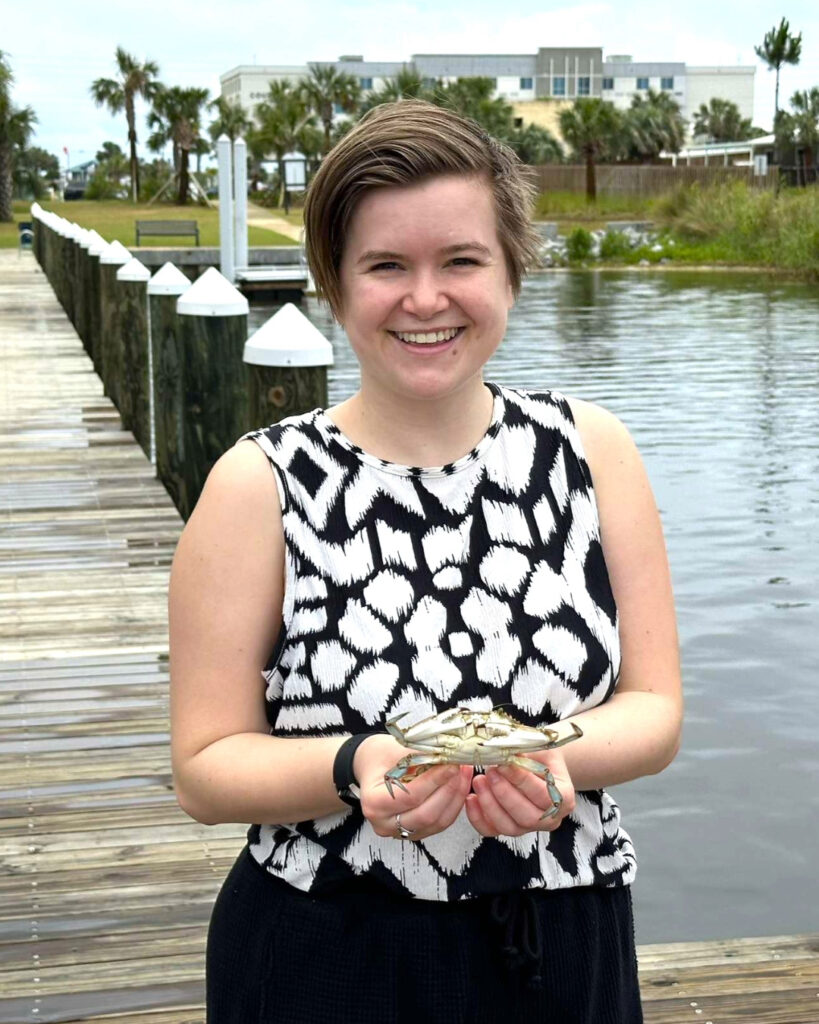What types of seafood products should you buy? Are farm-raised seafood products safe to eat? How does aquaculture impact our economy and environment? Florida Sea Grant’s Aquaculture Marketing & Communications Specialist, Emily Riewestahl, is here to clear up some murky misconceptions and uncertainties surrounding aquaculture.
Emily holding Blue Crab in Fort Walton Beach, FL.
In her role, Emily will develop marketing and communication strategies to boost public awareness of aquaculture products, their sources, uses, and benefits across the U.S. Southeast. She will lead education campaigns through the Southeast Aquaculture Communications Collaborative (SACC), which includes the National Sea Grant Law Center and Sea Grant programs in Texas, Louisiana, Georgia, and South Carolina.
This position is part of a broader initiative by the National Sea Grant Office (NSGO) to address communication and literacy needs that support the aquaculture community, seafood consumers, and the general public. Florida Sea Grant received $749,884 to support this Southeast collaboration, which includes Emily’s vital work.
“As the domestic demand for seafood increases, we have an opportunity to support growth in our domestic industry, especially as fish and seafood provide an efficient source of protein that is needed worldwide,” says Dr. Sherry Larkin, Director of Florida Sea Grant. “This project represents an opportunity to consolidate, educate, and highlight the breadth of societal, ecological, and economic benefits from local aquaculture and dispel misinformation and perceptions that can adversely affect the development of a thriving domestic industry.”
The necessity for a regional collaboration is driven largely by the expansive coastline and increasing population of the Southeastern U.S., characterized by a prominent aquaculture industry. The Southeast ranges in diverse aquaculture products including shellfish, finfish, ornamentals, bait and feed, sponges, algae, alligators, turtles, and restoration species including coral and seagrass. While Sea Grant Programs in the region have developed a wealth of information on aquaculture production in their respective state, there are no curated inventories of available resources, nor coordinated efforts to merge materials across the region.
To facilitate greater information exchange between state extension agents, researchers, and stakeholders, Emily will be tasked with building a website that will house aquaculture information and tools, and develop an interactive online education module. The project also includes working with the National Sea Grant Law Center to create a dashboard that summarizes local land use restrictions. To ensure target audiences are reached, products will be translated into languages of regional importance.
“As the new Aquaculture Marketing and Communication Specialist for the U.S. Southeast region, I am excited to work collaboratively with experts, producers, and the public to help people learn about aquaculture and discover ways they can support the ocean economy,” says Emily. “While I begin this position, I envision bringing my expertise in community-based humanities programming and digital outreach to help people see how aquaculture connects us all and calls us to take action.”
